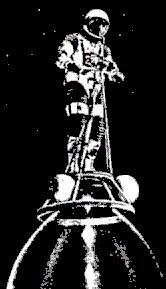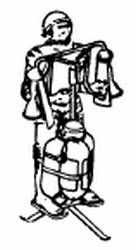
Home - Search - Browse - Alphabetic Index: 0- 1- 2- 3- 4- 5- 6- 7- 8- 9
A- B- C- D- E- F- G- H- I- J- K- L- M- N- O- P- Q- R- S- T- U- V- W- X- Y- Z
MOBEV F1B
 NAR Pogo Vehicle North American version of the one-man lunar pogo. Credit: via Jean-Christophe Carbonel |
Status: Study 1966. Gross mass: 82 kg (180 lb). Unfuelled mass: 49 kg (109 lb). Specific impulse: 290 s.
It relied on manual control obtained by thruster gimballing for pitch and roll, and jetavators for yaw. Communication was limited to the PLSS VHF line of sight, voice system. Navigation and guidance was done visually with aids such as maps and a sextant to determine initial flight direction. The F1B had a fueled mass of 82 kg, a range of 20 km, and would take $11.1 million and 24 months to develop.
LFV Concepts Summary
Pogo Single-Crew Surface to Surface
F1A F1B F1C
Fueled Mass(kg) 64 82 310
Range(km) 8 20 170
Crew Size 1 1 1
Development Cost($M) 10.6 11.1 13.4
Development Time(Mos) 24 24 24
Multiman Surface to Surface
F2A F2B F2C F2D F3A F3B F3C F3D
Fueled Mass(kg) 288 392 530 788 529 1074 2066 4209
Range(km) 20 50 100 200 50 200 400 800
Crew Size 2 2 2 2 3 3 3 3
Development Cost($M) 29.1 29.5 30.1 30.9 30.8 32.7 36.8 44.5
Development Time(Mos) 42 42 42 42 42 42 42 42
Surface to Lunar Orbit
F2E F3E
Fueled Mass(kg) 1106 1476
Crew Size 2 3
Development Cost($M) 33.0 34.8
Development Time(Mos) 42 42
Crew Size: 1.
Family: Lunar Flyers, Moon. Country: USA. Agency: NASA, Bendix.
 | Mvffb |
Back to top of page
Home - Search - Browse - Alphabetic Index: 0- 1- 2- 3- 4- 5- 6- 7- 8- 9
A- B- C- D- E- F- G- H- I- J- K- L- M- N- O- P- Q- R- S- T- U- V- W- X- Y- Z
© 1997-2019 Mark Wade - Contact
© / Conditions for Use